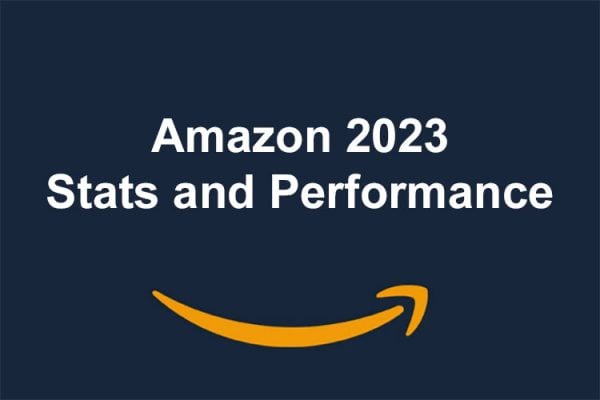How do your Amazon sales measure up against your competitors? It’s hard to judge sometimes, but Amazon do give some hints as to what their average seller looks like. Of course there’s really no such thing as average – e.g. some sellers will be 100% FBA, some will be 100% self fulfil and many will be somewhere in between – but today we’re going to try to define what the average seller looks like.
The Average Amazon Seller’s Turnover
We don’t know exactly how many third party merchants there are on Amazon, but two years ago Amazon revealed that there were over 2 million. We’re going to take a guesstimate at 2.25 million although there’s quite a large margin for error in that number.
The next data point we need to know is the total sales value from third party merchants on Amazon. Again we have to take an estimate at this number, but we do know for certain that Amazon took $22,993 million in seller fees. If we factor fees at 10% that equates to almost $230 billion in annual third party sales on Amazon.
Some simple maths ($230 billion divided by 2.25 million) gives us a turnover for the average third party Amazon seller of $115,000 annually or around £92,222 – That’s £7685/month so if your Amazon revenue is in that ball park, congratulations – you are Mr or Ms Average!
The Average Amazon Seller’s FBA Business
FBA delivered more than two billion items for Marketplace sellers worldwide last year. A simple division suggests that the average Amazon seller sells just 74 FBA items per month.
The proportion of sales going through FBA is currently running at more than 55% of total third-party units. This means that Mr or Ms Average will be selling around £51,000 annually through FBA or £4227 per month. The remaining £3431 of monthly revenue will be from self fulfilled items.
The Average Selling Price on Amazon
Knowing that the average seller shifts 74 items per month through FBA generating £4227 of revenue we can estimate an Average Selling Price of just over £57 per unit.
The Average Amazon Seller’s Growth
Amazon increased their seller fees by 37% from 2014-2015 and 43% from 2015-2016. This isn’t a fee increase, it’s simply down to sellers selling more. If fees grew at these levels then it’s reasonable to assume that sales grew in the same proportion.
Of course new sellers will have started selling on Amazon and some will have ceased trading. Until Amazon updates their seller numbers we’re guessing that overall growth is relatively slow and as above allowed a quarter of a million over the last known number, a rough 11% growth in the number of active Amazon merchants.
Allowing for an 11% growth in merchant numbers, this means the average seller should have seen their business swell by around 33% in 2014-2015 and 38.75% in 2015-2016.
If your Amazon business isn’t growing at least 30-40% year on year then something is wrong and you’re falling behind Mr or Ms Average.
How To Accelerate Your Amazon Sales
Amazon have revealed that active sellers worldwide using the FBA service grew more than 70% and that, outside the US, FBA units shipped grew more than 80%. More sellers are using FBA and those do are seeing their FBA unit sales skyrocket compared to sellers who self fulfil.
If you want to perform better than Mr or Ms Average, putting your products into FBA is the sure fire way to succeed on Amazon.
The Average Amazon Seller Summarised
The average Amazon seller will be turning over close to £8000 per month on Amazon and their business will be growing at up to 40% year on year. They will heavily use FBA, probably for their fastest selling lines, and will be selling internationally allowing Amazon to fulfil their orders around the world with FBA.
Mr or Ms Average will be growing their FBA business considerably faster then their self fulfil business and will enjoy an average price per unit of almost £60.
Whilst we acknowledge that some of these number are estimates, and others calculated using assumptions which may not be accurate, they do give an interesting insight into what the average Amazon merchant looks like. Some will have considerably higher or lower turnover both in monetary value and in the number of units sold.
We have only looked at turnover and units sold. Your profit is what really matters an margins between different products will vary wildly. You may have much lower cost products but higher margins and make as much profit as some turning over many times the same revenue as you.
How do you measure up against Mr or Ms Average Amazon seller? Are you performing better, worse, or have we just described your Amazon business?











4 Responses
This is what Tamebay was created for! Thank you Chris. Very well written. Loved the approach to figuring out the average. Of course we have to account for the fact the reported figure of sellers on amazon is grossly overstated by Amazon. To look good from Growth perspective they report all accounts, whether they not active or have minimal activity as “Sellers”, we can confidently divide this figure by lets say 4 (finger in the air by the way)
Do not USE FBA . It does increase your sale but if you are LUCKY and your account get suspended or get CLOSED than AMAZON will not return your FBA products. Funny thing is that they will start selling your products and take all money and will not give you anything.
That is just one of the concerns that I have with using FBA